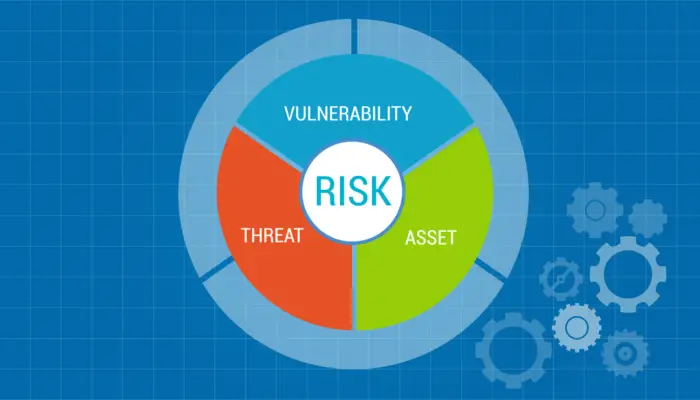In today’s complex financial landscape, combating money laundering has become a top priority for businesses and regulators alike. Demystifying AML Risk Assessment: An Essential Tool for Fighting Financial Crime explores the crucial role of AML risk assessment in detecting and preventing illicit financial activities.
Through a clear understanding of its fundamental principles and practical application, organizations can ensure compliance, mitigate risks, and contribute to a more secure financial ecosystem.
This comprehensive guide delves into the key components of an AML risk assessment framework, offering valuable insights and actionable tips to strengthen your organization’s anti-money laundering efforts.

What is AML Risk Assessment and Why is it Crucial?
AML risk assessment is a systematic process that enables organizations to identify, evaluate, and prioritize potential money laundering and terrorist financing risks. This vital component of an effective anti-money laundering (AML) program helps organizations stay compliant with relevant laws and regulations, allocate resources efficiently, and protect their reputation.
A well-executed AML risk assessment involves assessing the organization’s inherent risks, evaluating the effectiveness of existing controls, determining residual risks, and formulating appropriate mitigation measures. By conducting regular risk assessments, organizations can adapt to the ever-changing landscape of financial crime and improve their overall AML efforts.
The Fundamentals of Anti-Money Laundering
Anti-money laundering (AML) is a set of policies, procedures, and regulations aimed at preventing the generation of income through illegal activities and concealing the true source of illicit funds. Money laundering often involves three stages: placement, layering, and integration.
Financial institutions and businesses play a critical role in detecting and preventing money laundering by implementing robust AML programs, which include risk assessment, customer due diligence, transaction monitoring, and reporting suspicious activities to relevant authorities.
The Goals and Benefits of AML Risk Assessment
AML risk assessment is an essential component of an effective AML program. Its primary goal is to identify and assess the potential risks that an organization may face in relation to money laundering and terrorist financing. The benefits of conducting a thorough AML risk assessment include:
- Enhanced understanding of the organization’s risk exposure.
- Compliance with regulatory requirements.
- Protection of the organization’s reputation and financial stability.
- Improved allocation of resources to mitigate risks more effectively.
- Strengthened overall AML program by identifying areas for improvement.
Legal and Regulatory Requirements for AML Risk Assessment
Organizations are required to conduct AML risk assessments to comply with various legal and regulatory frameworks. These requirements may vary depending on the jurisdiction and industry sector. Some of the key regulations that mandate AML risk assessment include:
- The Financial Action Task Force (FATF) Recommendations: These are international standards that provide a framework for countries to develop and implement effective AML and counter-terrorist financing measures.
- The Bank Secrecy Act (BSA) in the United States: This act requires financial institutions to establish and maintain AML programs, including conducting risk assessments and implementing adequate controls.
- The European Union’s Anti-Money Laundering Directives: These directives provide a comprehensive legal framework for EU member states to combat money laundering and terrorist financing, including the requirement for businesses to perform AML risk assessments.
Key Components of an AML Risk Assessment Framework
An effective AML risk assessment framework comprises several essential components that work in synergy to identify and mitigate money laundering and terrorist financing risks. These components are critical for organizations looking to establish a robust AML program that aligns with regulatory requirements and industry best practices.
Customer Due Diligence (CDD)
Customer Due Diligence forms the foundation of a solid AML risk assessment framework. CDD involves collecting and verifying customer information, understanding the nature and purpose of their business relationships, and assessing the associated money laundering risks.
Enhanced Due Diligence (EDD) should be performed for high-risk customers or transactions, including politically exposed persons (PEPs) and customers from high-risk jurisdictions. Regularly updating customer information and risk profiles is essential to maintain the effectiveness of CDD measures.
Monitoring and Detecting Unusual Transactions
Continuous transaction monitoring is crucial for detecting unusual or suspicious activities that may indicate money laundering or terrorist financing. Organizations should establish clear thresholds and indicators for identifying high-risk transactions, including large cash deposits, rapid movement of funds, and transactions with no apparent economic purpose
Implementing sophisticated monitoring systems and leveraging data analytics can enhance the detection of suspicious transactions and facilitate timely reporting to relevant authorities.

Risk Rating and Categorization
Assigning risk ratings to customers, products, services, and geographic locations is an important element of an AML risk assessment framework. Risk categorization helps organizations prioritize resources and tailor their AML controls to address specific risks effectively.
Factors to consider when determining risk ratings include customer type, business activity, transaction patterns, and country risk. Periodic reviews of risk ratings ensure that the organization’s AML program remains responsive to evolving risks.
Effective Policies and Procedures
Well-defined policies and procedures serve as the backbone of a successful AML risk assessment framework. These should be tailored to the organization’s risk profile and cover all aspects of the AML program, including CDD, transaction monitoring, reporting, record-keeping, and employee training.
Policies and procedures should be communicated clearly to all relevant personnel and updated regularly to reflect changes in regulations, industry practices, and the organization’s risk environment. Implementing strong internal controls and conducting periodic audits are vital to ensure the effectiveness and compliance of the AML policies and procedures.
Implementing a Risk-Based Approach to AML
A risk-based approach to AML enables organizations to allocate resources efficiently and focus on areas with the highest money laundering and terrorist financing risks. This approach involves identifying inherent risks, assessing the effectiveness of existing controls, determining residual risks, and prioritizing mitigation measures.
Regular reviews and updates of the AML risk assessment are crucial for maintaining its effectiveness.
Identifying Inherent Risks in Your Business
The first step in implementing a risk-based approach is to identify the inherent risks within your business. This involves examining your organization’s products, services, customers, delivery channels, and geographic locations to pinpoint potential vulnerabilities to money laundering and terrorist financing.
Consider factors such as customer types, transaction volumes, and the regulatory environment when evaluating inherent risks.
Assessing the Effectiveness of Existing Controls
After identifying inherent risks, evaluate the effectiveness of your organization’s existing AML controls. This assessment should cover customer due diligence, transaction monitoring, reporting, and training procedures.
Analyze the controls’ ability to detect and prevent illicit activities, and identify any gaps or weaknesses that need to be addressed.
Determining Residual Risks and Prioritizing Mitigation Measures
Once you have assessed the effectiveness of existing controls, determine the residual risks, which are the remaining risks after controls have been applied. Prioritize these risks and develop mitigation measures to address them. This may involve enhancing existing controls, implementing new ones, or adjusting risk appetite.
Ensure that the mitigation measures are proportionate to the risks and aligned with your organization’s strategic objectives.
Reviewing and Updating Your AML Risk Assessment
The risk landscape is constantly evolving, making it crucial to review and update your AML risk assessment regularly. This process should involve reassessing inherent risks, evaluating the effectiveness of controls, and updating risk ratings and mitigation measures as needed.
Keep an eye on regulatory changes, industry trends, and emerging threats to ensure your AML program remains relevant and effective.
Challenges in AML Risk Assessment and How to Overcome Them
AML risk assessment can be a complex and demanding process, with several challenges that organizations need to address to ensure its effectiveness. The following explores the common obstacles in AML risk assessment and offers practical solutions to overcome them.
Data Quality and Availability
Accurate and timely data is crucial for a successful AML risk assessment. However, organizations often face challenges in accessing and maintaining high-quality data. To overcome this hurdle, invest in reliable data sources, implement data validation processes, and leverage advanced data analytics tools.
Regularly update customer information and risk profiles to ensure that your AML program remains responsive to changes in risk.
Balancing Efficiency and Thoroughness
Striking the right balance between efficiency and thoroughness in AML risk assessment can be challenging. Organizations must ensure they cover all essential aspects while avoiding excessive resource consumption.
Streamline your risk assessment process by adopting a risk-based approach, automating repetitive tasks, and optimizing your transaction monitoring systems.
Additionally, focus on continuous improvement and adaptability to achieve a more efficient and effective AML risk assessment process.
Addressing the Ever-Changing Landscape of Financial Crime
Financial criminals continuously evolve their tactics, making it difficult for organizations to keep up with the latest threats. Stay ahead of emerging risks by monitoring regulatory changes, industry trends, and technological advancements.
Participate in industry forums, attend relevant conferences, and collaborate with peers to exchange best practices and insights. Provide regular training for employees to ensure they are up-to-date on the latest AML techniques and trends.
Collaboration and Information Sharing
Effective collaboration and information sharing are essential for combating financial crime. However, organizations often face challenges due to data privacy concerns, jurisdictional issues, and lack of standardization. Foster a culture of cooperation by engaging with regulators, law enforcement agencies, and industry peers.
Leverage cross-border information sharing platforms and participate in public-private partnerships to enhance collective efforts against money laundering and terrorist financing.
Measuring the Success of Your AML Risk Assessment
Effectively measuring the success of your AML risk assessment is essential to maintain a robust and compliant anti-money laundering program.
This section explores the key aspects to consider when evaluating the performance of your AML risk assessment, ensuring continuous improvement and fostering a culture of compliance.
Key Performance Indicators (KPIs) for AML Risk Assessment
Monitoring relevant Key Performance Indicators (KPIs) helps organizations assess the efficiency and effectiveness of their AML risk assessment process. Some essential KPIs to track include:
- Number of high-risk customers identified.
- Percentage of timely completed customer due diligence reviews.
- Efficiency of transaction monitoring systems.
- Number of suspicious activity reports filed.
- Effectiveness of employee training programs.
Tracking these KPIs allows organizations to identify areas for improvement and measure the success of their AML risk assessment efforts.
Internal and External Audits
Regular internal and external audits play a crucial role in assessing the success of your AML risk assessment. Internal audits help organizations identify gaps in their AML programs and ensure compliance with internal policies and procedures.
External audits, conducted by independent third parties, provide an unbiased assessment of the organization’s AML risk assessment process and adherence to regulatory requirements. Implementing a robust audit program ensures continuous improvement and compliance with industry standards.
Continuous Improvement and Adaptability
A successful AML risk assessment process should be adaptable to changes in the regulatory landscape, industry trends, and emerging threats.
Embrace a culture of continuous improvement by regularly reviewing and updating your risk assessment framework, policies, and procedures. Stay informed about new technologies and best practices to enhance the efficiency and effectiveness of your AML risk assessment.
Ensuring a Culture of Compliance
Cultivating a strong culture of compliance within your organization is critical to the success of your AML risk assessment. This involves fostering a top-down commitment to compliance, providing regular training and education for employees, and promoting open communication channels for reporting concerns.
A compliant culture not only helps organizations meet regulatory requirements but also contributes to the overall success of their AML risk assessment efforts.
Conclusion
AML risk assessment is a vital component in the fight against money laundering and financial crime. In demstifying the process and understanding its importance, businesses can better protect themselves and contribute to a safer financial system.
As financial crime becomes more sophisticated and the regulatory landscape evolves, businesses must continuously adapt and improve their AML risk assessment processes. Embracing a risk-based approach, staying informed of industry best practices, and fostering a culture of compliance are essential in maintaining a strong anti-money laundering program.
Ultimately, a comprehensive and effective AML risk assessment serves as the foundation for protecting not only an organization’s reputation but also the integrity of the global financial system.

Chris Ekai is a Risk Management expert with over 10 years of experience in the field. He has a Master’s(MSc) degree in Risk Management from University of Portsmouth and is a CPA and Finance professional. He currently works as a Content Manager at Risk Publishing, writing about Enterprise Risk Management, Business Continuity Management and Project Management.


